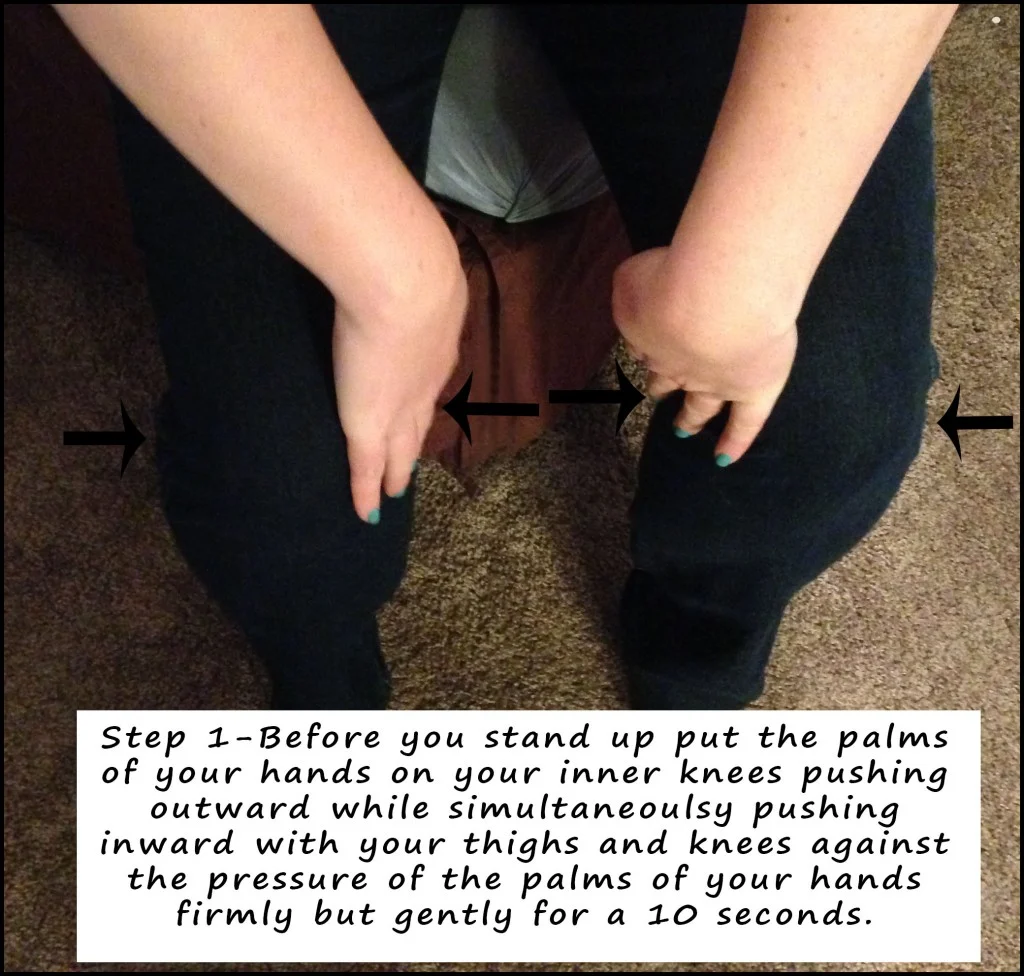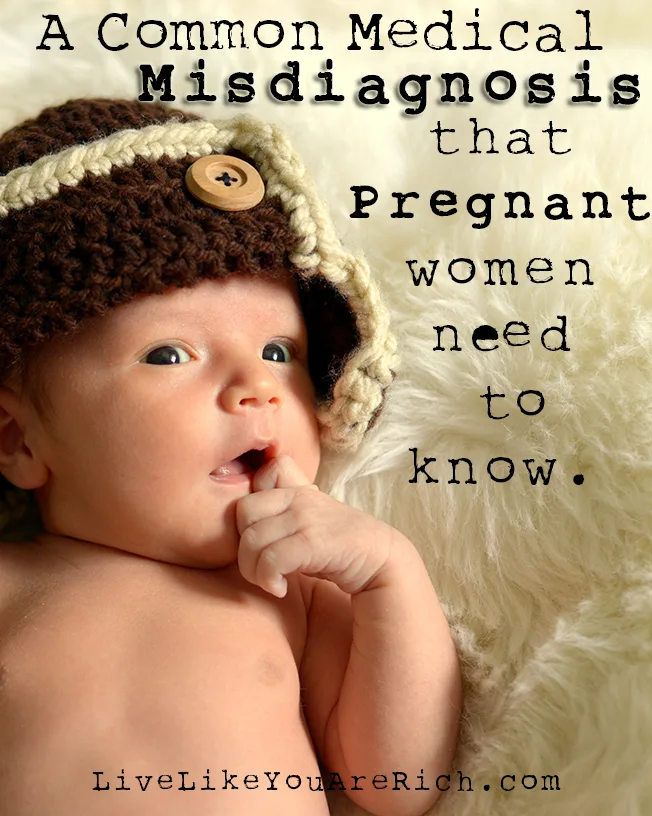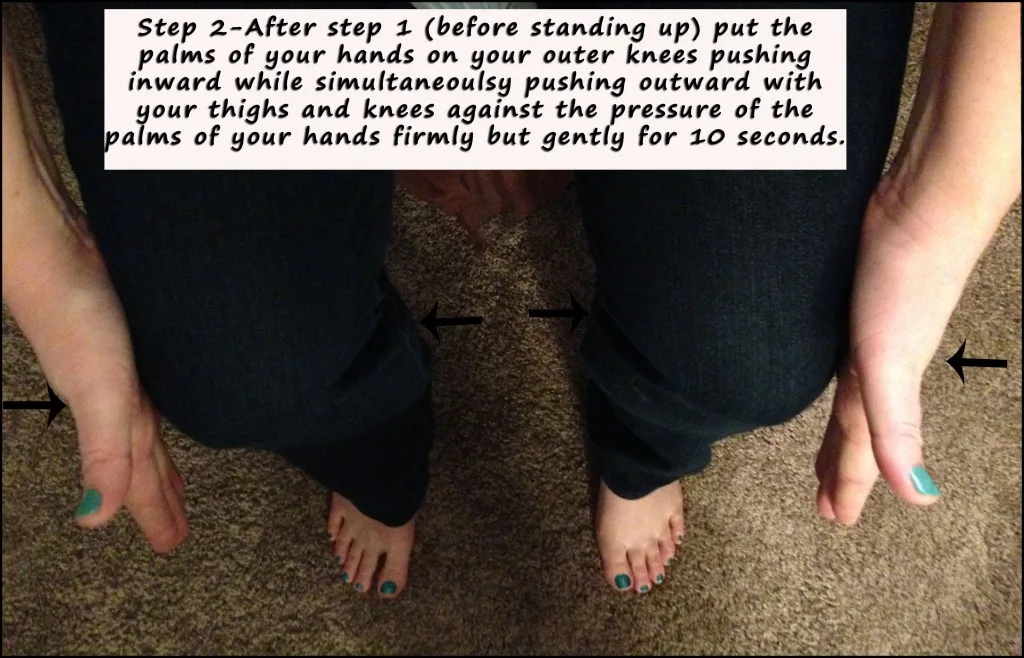Early one morning about 4 months before my son’s due date, I stood up out of bed. A horrendous stabbing pain shot through my lower pelvic area and thighs. It hit me so hard I immediately fell to the floor. I didn’t even have time to reach out to the wall or bed to catch myself. One second I was on my feet, the next I was on the floor. I tried to move but couldn’t. I just lay there. Eventually the pain went away enough that I could crawl back into bed.
I thought maybe it was a freak accident and tried a while later to stand up but the pain shot through me again. This time I fell back onto my mattress. I had to use the bathroom so I slowly lowered myself to the floor and crawled there, hoisted myself up on the toilet and crawled back and hoisted myself back into bed.
I wrote a post on Facebook explaining what I had experienced and I was flooded with comments from kind friends explaining what they thought it could be. The majority of them said, Sciatica.
I began doing research and found out as much as I could about not only Sciatica but anything that could explain the pain I was feeling and the symptoms I had.
I read all the pregnancy forums, articles, medical journals and anything I could find on the subject. Everything I read pointed to Sciatica.
My OB and midwives diagnosed me with having Sciatica.
I went to a pregnancy chiropractor and although she helped me significantly with the weekly alignments, she had a similar diagnosis. Sciatica.
I even cried with a lady down the street who has been a long time sufferer of Sciatica. It was one of the kindest things. She read my post and later at church she came over to me and told me she has been a long time sufferer of it and gave me a hug and we just commiserated together.
So naturally, I thought I had Sciatica. I didn’t. And not knowing the correct diagnosis caused me an immense amount of both physical and emotional pain.
It wasn’t even until I sat down to write this article that I found out I actually had Pelvic Girdle Pain. (Originally I was going to write about pregnancy-related-Sciatica and what to do to help with the pain). After I found out that what I suffered from for four long months was Pelvic Girdle Pain, I was in denial. Everyone I knew, including medical professionals, and my friends all thought I had Sciatica. But I kept reading and researching until I was convinced everyone’s (including my own) diagnosis of my pain was wrong.
When I was sure about the misdiagnosis, I hung my head and couldn’t help but cry. I cried because of the intense fear that I had had while pregnant – that I’d have Sciatica for life – was unnecessary. I cried because of the guilt I experienced when other pregnant women would say that they have/had Sciatica too and it wasn’t ‘all that bad’. I cried because of the constant worry I had had for four months about whether I would be able to care for a newborn without being able to consistently walk. And I cried because the correct diagnosis of Pelvic Girdle Pain could have significantly changed my pregnancy and reduced my pain.
Recently, experts and pregnancy websites have come out and said that if you are/were pregnant and think or have been told you have/had Sciatica, most likely you DO/DID NOT have it and that it is/was actually Pelvic Girdle Pain. That was a little confusing to read so here is Babycenter.com’s exact quote, “If you think, or have been told, that you have Sciatica, 99% of the time you have PGP.”
This may make you mad. It may make you scream at the computer and say but I SUFFERED or am SUFFERING from Sciatica… it may even make you cry, like it did me. 1% of you have/had it… the 99% of us don’t/didn’t.
Like I briefly mentioned, most of the things I was told to do to relieve pain associated with Sciatica caused me additional pain. And when something is already so painful you feel like you have a knife in your pelvic bone, and have to crawl around on your knees to get anywhere, adding extra pain is just something you can’t afford to do. Yet, trying to treat PGP like it was Sciatica is, in most cases, exactly what I did.
For example:
- When you have Sciatica they recommend you not sit still or lie down for long periods of time and keep moving. This caused me an enormous amount of pain, stress, and guilt because I found that moving caused me additional pain. I didn’t want to be ‘lazy’ so I kept trying to move and it made things worse. So finally I gave into my body, I put myself on semi-bed rest, and began to feel much, much better. Yet, I still had guilt every day for being in bed when everything I heard and read said, I ‘should’ be up moving. Contrary to this advice, when you have bad PGP you are supposed to rest as much as possible.
- When you have Sciatica they recommend you lightly exercise. If I exercised (even lightly), I was basically doomed to crawl for the next few days because of the intense pain it had caused. But, when you have severe PGP they tell you to not exercise and if you do exercise, take it very easy because the pain is relative to your activity. Basically, you will be in more pain the more you move, which I found to be very true.
- When you have Sciatica they tell you it has to do with your nerves, spine and discs. Besides treatments that are dangerous while pregnant, expensive procedures, and pain pills (which I did not want to take for sake of my son) there is very little to nothing you can do for it. With PGP you can do many things to relieve the pain. You can get chiropractic adjustments, physiotherapy, osteopathy, acupuncture, and do many techniques at home to help to realign your pelvis. And there are other things mentioned below that can help as well.
- When you have Sciatica they tell you that it is a lifelong condition and is not specifically pregnancy related. Meaning most likely it is from an injury and the pregnancy just made it worse AND it’s not going to go away. Since I was an amateur snowboarder I had had multiple injuries, I thought that it probably came from that. This caused me a ridiculous amount of fear thinking and wondering about how I was going to care for a newborn if I couldn’t even walk. When you hear these discouraging things, you really are left hopeless, wondering if you are destined to a life of crutches, medicine, and pain. With PGP they tell you the pain will go away when you have the baby or soon after.
- And when you think you have Sciatica, women and people can make rude comments that hurt emotionally. Some I heard were, “I had Sciatica and it wasn’t that bad.”, “Oh, it’s just a little Sciatica”, “My friend had Sciatica and was still able to exercise, or walk fine, or__________”. After all, people typically think Sciatica is a pinched nerve. So shouldn’t one pinched nerve feel like another’s pinched nerve? So if one person can exercise with ‘Sciatica’ then the next should be able to as well, right? It does sound logical and if what we all really had was Sciatica perhaps it would be true. But, when you are suffering from PGP you understand that there is a range of pain people feel.
PELVIC GIRDLE PAIN
PGP is a condition that happens to many pregnant women when the pelvic area is tilted, slanted, or out of alignment. The amount that the pelvic bone is tilted slanted or out of alignment is in direct correlation to the pain a woman feels. Think of it like this. Most women experience some form of pelvic discomfort while pregnant, so most are going to understand what it feels like to have the pelvic area hurt. But, the pelvis can be a tiny bit off, completely twisted, tilted forward or backward, or going all different directions at once. The pain can range significantly based on a woman’s pelvis, say on a scale from 1-10 (1-being slight discomfort and 10- being you can’t even walk).
Understanding PGP could have helped me explain it to those making ignorant rude comments. Or perhaps I would have just smiled and brushed it off. Not knowing this, I was left wondering if I had an extremely low pain threshold. Or if I was making excuses because I didn’t want to be able to walk (who really doesn’t want to walk?), or work (understandable), or shop (if anyone knows me they know I love to coupon and shop!). I doubted myself and wondered if I had just turned into a ‘complainer’, or if I was just a loser and had become a completely irrational pregnant woman. Seriously, I had these thoughts and I had them often.
PGP is a very real and serious diagnosis and I am certainly NOT SAYING that it is more or less painful than Sciatica. Only that it is different. With all this misdiagnosis it is not surprising that symptoms are very similar, almost the same and that is why it is so commonly misunderstood.
The few things that helped me diagnose myself correctly are:
1- With Sciatica, the pain usually goes down into your lower legs and feet (mine was more localized to my Pelvic area).
2- With Sciatica, the pain is usually on one side (PGP is either one side or both and mine was both).
3- With Sciatica, the pain waxes and wanes and is often numbing (my pain was very consistent and I never felt numb without use of ice-packs).
Using the remedies of both diagnoses I was able to figure it out.
- Almost everything that should make someone feel better with Sciatica made me feel worse.
- Everything that should make someone feel better with PGP, made me feel better.
The reason why this article is entitled a ‘common’ medical misdiagnosis, is because most women who have experienced any type of pelvic pain have been told or thought that it is/was sciatica. I was told by over 50 women who said they all experienced some form of sciatica. 49.5% of them didn’t know that what they really had was PGP. I’m hoping that my experience can help others.
What Helped Me to Relieve What-I-Thought-Was-Sciatica,
but What Really-Was-Pelvic-Girdle-Pain
- One of the best things for extreme PGP is resting! Seriously, talk to your doctor or midwife and tell them the situation you are in. See if they think it would be appropriate to put you on bed-rest or a semi-bed-rest schedule. This is may help you ask your boss if you can work from home or tell friends, families, etc. that you can’t make it to certain functions or activities without them being offended. It can help to remove any guilt you may have for not being active and involved like you once were.
- Frequent pelvic treatments (physiotherapy, chiropractic therapy, osteopathy, physical therapy, etc.) When you are pregnant you have the hormones Relaxin and progesterone in your body which loosen and soften your bone structure. It is very easy for things to get moved out of place. So these treatments may not last as long as you would like, yet they are very helpful. Luckily, I had a few friends who said they had sciatica and told me to try a chiropractor. Not surprisingly, (since I really had PGP) the chiropractic treatments really helped!! Although the adjustments were painful, I could walk without debilitating pain for a few days after. Because the Relaxin and progesterone I would have to go back every 3-5 days. It was expensive but worth it!
- A mattress topper WAS HEAVEN – Get a thick dense mattress foam topper, like this one. If you can’t afford a new one, buy a relatively new used one. They are worth their weight in gold.
- Pillows, especially this Boppy pregnancy pillow. Pillows helped me sleep and lie soooo much more comfortably. Lie on your side, put a pillow in between your legs, one under your knees, one under your feet, one on each side, and some under your neck and head. Other women have found success by sleeping in a very comfortable recliner.
- Before you stand up, do this movement and it will help to realign your pelvic bone. A physical therapist told my friend, who then told me and I couldn’t believe how well it worked!
Here are photographs of how to do it…
7. Wear flat shoes- This really could go unsaid because if you have really bad PGP high heels look like a death trap, but needless to say, avoid them.
8- Go to a professional chiropractor or the like that can measure your legs. If one is shorter than the other they will give you a little rubber lift to put into your shoe. This will help your pelvis remained aligned for longer. Even using a lift, I still required an adjustment every 7-10 days but it made the pain less intense and helped my adjustment last longer.
9. Use crutches, a walker, a cane, or a wheelchair. Use them when you have to do something and know you may not be able to without assistance. Don’t feel ashamed, they are there for people who are in extreme pain like you.
10. A belly band– I invested in a very high quality belly band like this. It helped a lot when I wore it.
11. Ice- Heat made things worse for me, (bye bye warm baths)… The ice numbs the pain. With my PGP I had the pain all over my lower back, pelvic bone, hip bones, buttocks, and back upper thighs, yet icing all over for a few minutes did bring relief.
12. Subsequent pregnancies may not be as bad. This is an update two years after writing this article. After having my son, I was terrified of having another and going through this pain again. Add to that the fact I had a one and a half year old to care for made me very anxious. But the good news is, my daughter was positioned much differently than my son. She wasn’t twisting and pushing on my pelvic bones. I still had slight pelvic pain and saw a chiropractor once every six or so weeks, but the pain was manageable and not debilitating like it was my first pregnancy. So just know, you may have it better if there is a next time around. End of update.
Finally, there is hope. A few days before I went into labor (when my son was down further in the birth canal), I was up walking and feeling better than I had in months. I was on the treadmill, taking long walks and enjoying the freedom and the ability to walk again. (Walking is something I’ll never take for granted again).
The day after I came home from the hospital my mom asked me, “Did you have stitches”, I said, “yes” and she said, “You would never know it, you are moving so much better than I have seen you move in months!” I told her it was because the ‘Sciatica’ (really the PGP) pain was gone.
5 months post-partum I ran a 5K and at 7 months postpartum I ran my first 10k. I have been able to be active and take care of my son without any pelvic pain. Some people do experience this pain for a few months postpartum, but getting alignments and some of the other techniques that help with PGP should help it go away.
All Pelvic Girdle Pain and Sciatica sufferers deserve the upmost respect and compassion that their friends, families, and acquaintances can bestow. They need love, sympathy, hope, and encouragement for what they have been through or are going through. Because of the unbelievable pain they endure, they truly deserve it.
For other ‘rich living’ and pregnancy/postpartum tips please subscribe, follow me on Pinterest, and like me on Facebook.





Ice Cream N Sticky Fingers
Thursday 6th of June 2019
My third pregnancy was very difficult and I suffered from extreme pelvic pain and had no idea that this condition wasn't normal. I had back problems and chalked up my pain as my hips spreading in preparation for birth. But little did I know that I was actually suffering from SPD and should have pushed my doctor for a pregnancy belt. Any small movement was so painful and I wish that I knew what I know now while I was still pregnant.
Sara
Thursday 18th of April 2019
Thank you so much for writing this! I am 25 weeks pregnant and was diagnosed with sciatica and sent to physical therapy for it, after the first visit I quit because I felt worse. The therapist had me in the stationary bike when I can barely lift my legs! My pain started in my lower back and my body tilted to one side, I now have a higher hip along with pain on the buttocks and right leg. I can’t stand up straight as I feel my pelvic bones can’t support my upper back. I also can’t move my hips in bed and use my hands to move them up slowly to turn. I went to a chiropractor but didn’t help much and I have decided to just rest as much as possible and my husband does all housework. Hope it goes away after delivery😭
Heather
Wednesday 17th of April 2019
This article has brought me so much relief! I struggled with severe pelvic pain when I was pregnant which I thought was round ligament pain and which the doctors didn't seem at all concerned about. I have a high pain tolerance so I powered through it with all my daily activities which is why so many people didn't think it was that bad but it was literally the worst pain in my life. I literally would rather go through labor again than feel that ever (and I naturally labored for over 24 hours). My sister was pregnant at the same time and was doing just fine so I stupidly allowed that to pressure me into powering through my pain and feeling guilty about curling up on the couch for long periods at a time. I am now convinced that PGP is what I was suffering with.
But the biggest relief about this article is not only the validation but also the comment that my future pregnancies might not bring the same pain! I know that it's not a promise but at least there is some hope. And that I do have that pain, there are things I can do about it!
Thank you!
Anita
Thursday 18th of April 2019
I'm glad this helped you!
Ashley
Tuesday 12th of June 2018
Wow. I experienced the exact same discomfort and pain. It was worse after I gave birth I couldn’t really walk and had a physical therapist tell me I was fine which made me angry because I wasn’t and I knew it. This is definitely helpful and I a misdiagnosed I was told sciatica nerve. I went to the chiropractor if it weren’t for him I wouldn’t be able to walk I remember the fear and tears and not knowing how I was going to be able to take care of my baby. Definitely so painful and scary and thinking I may not be able to walk again or get around. I had to see the guy two times he said he’s never seen or had someone like my case said it was the worse he’s ever seen. Thankfully he helped me and I’m back on my feet!
Anita
Thursday 27th of September 2018
So so glad you went to a chiropractor and are back on your feet. I can't imagine having a new born and dealing with this kind of pain. Best of luck to you and I hope it goes away or at least is manageable with adjustments or a shoe/foot lift.
Angie
Friday 18th of May 2018
I’m suffering from PGP/SPD currently, and cannot wait to get some relief, I’m 33 weeks and it started at 24 weeks. My first pregnancy in 2015 had me immobile by 34 weeks due to PGP, my hip dislocated and my legs were 1.5” difference in length. I resorted to bed rest and was induced at 39 weeks due to the severe pain. I was seeing a PT three times a week before birth and for months following. I was able to deliver naturally (Labor was less painful than the PGP) an an epidural was risky bc my hips did not align and bending forward for the medication caused me too much pain. Since that birth, 3 years ago, I have continued physical therapy and sit on a medicine ball at work. It took me two years to consider getting pregnant again, and I was disappointed with the support I received (many other mom’s saying they had SPD or PGP and it wasn’t that bad). Now pregnant again, I have been doing preventative physical therapy since 14 weeks, but the pain is back. I did lots of research this time around and found the only brace support that has helped me (I’ve tried three other types with no luck). If you suffer from PGP or SPD I highly recommend it as I think it’s the only reason I’m still able to walk. Maternalift I have tried chiropractic care and even the PT doesn’t help much, rest is really the only thing that provides me any relief. I feel for anyone experiencing this same situation, as I don’t know anyone personally that has experienced it to the degree I have, and it’s hard to explain to people. My baby is measuring very large this pregnancy which has me nervous about delivery and possibly further damaging my fragile pubic bone and hip area. Any advice on that front is greatly appreciated.
Anita
Thursday 27th of September 2018
Thank you. It is VERY painful if you have it like many of us commenting have. I'll look into this Maternalift.